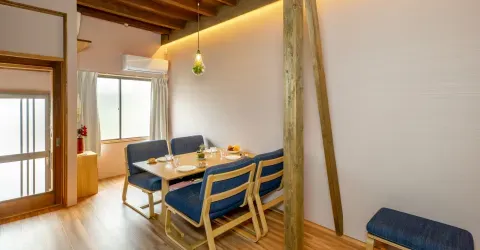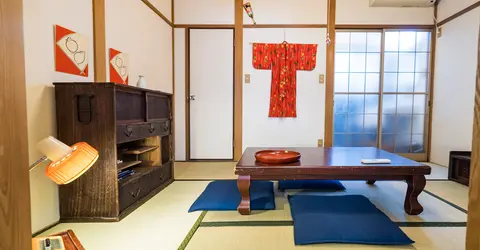Cycling in Kyoto
Read an article on cycling in Kyoto, Japan: the pros and cons of seeing the ancient city on two wheels.
Cycling in Kyoto 自転車

Kyoto is the one city all tourists will visit when they come to Japan. It is a big city, and getting around to the many temples and shrines and sites will therefore take a bit of planning.
Geographically, Kyoto is located in a bowl, surrounded on three sides by mountains, and thus relatively flat. The city is modeled on Xian, the ancient Chinese capital, and therefore - unlike every other Japanese metropolis - laid out on a checkerboard grid. And much of it is very compact, having been built centuries ago.
Sounds like a cyclists' paradise, right?
Yes and no.
Cycling is but one of many alternatives for getting around the city. Downtown you will walk, and for moving around the city Kyoto does have a decent public transportation system.
There are two subway lines, one Japan Railways (JR) line (good for Arashiyama), a comprehensive bus system (though slow at peak times of the year), and two trolley lines.


However, to really see the city nothing beats a bike.
If the weather is good, this remains the best way to get around, especially if you divide the city up geographically - and tackle it on a section by section basis.
Kyoto is both a college town and a company town. Kyocera, Nintendo, Wacoal, Rohm, Omron, Murata are a few of the major corporations founded and based in Kyoto. As a result, there is a lot of college and salaryman bike traffic on the streets.
Great! Lots of company on the roads, you think.
Yes, you on your rental bike will not be alone on the streets of Kyoto.
However, the problems with cycling in the ancient capital are numerous though not insurmountable (and with a bit of political will could be solved).
First, Kyoto has no bike lanes. The picture at the top is of a "lane" painted onto a sidewalk. Both pedestrians and cyclists weave in and out of the "bike" area and the non-bike area. Moreover, bus stops are located in these lanes, which means that cyclists have to leave the lane to go around or through people waiting for the bus. (In the photo directly above left, a woman is walking in the bike lane while a young man is riding in the pedestrian lane.)
Unlike Amsterdam, Copenhagen, Barcelona, London (pictured below, near Russell Square), and some US cities - Portland and now even New York - you will not be riding smoothly and safely in bike-only lanes. Instead, for much of your travels you will be sharing the road with taxis, buses, delivery trucks, and a lot of private vehicles.
In comparison with US drivers, though, Japanese drivers tend to be polite and, more important, expect to see cyclists on the road. Awareness of and sensitivity towards cyclists in Kyoto is much higher than in American cities.
Having said that, though, you should be very alert. In particular, taxi drivers and K-trucks (small white trucks used by contractors and some delivery companies) can be aggressive.

Second, many streets have no sidewalks. Except for larger boulevards that do have a bike "lane," you will be sharing the road with all of the above vehicular traffic and pedestrians. Think obstacle course.
Next, although it is technically illegal to ride on the sidewalks that do exist, the police do not enforce this (which can make walking on sidewalks unpleasant). As a result, many cyclists do ride along the sidewalks, jumping from street to sidewalk and back at full speed. Wherever possible, you should avoid this. Bike on human accidents are very common.
Last, because of a quirk in Japanese traffic law the bigger party is always considered at fault in an accident smaller vehicles, etc., often move about with a great amount of impunity.
Cyclists, for example, know that cars have to avoid hitting them, or face punitive damages even if the cyclist is at fault.

You will thus see: a person on a bike, iPod ear pods inserted, no helmet, riding on the wrong side of the street towards oncoming traffic (and cyclists). In many years of cycling in Kyoto, I have even witnessed cyclists listening to music and text messaging at the same time while going the wrong way on a busy street.
Beware of bicycle idiots.
Lest we give the impression that all is not well on the streets of Kyoto, it is worth repeating that the city is flat, small enough, easy to navigate and there is much less aggression on the roads than almost anywhere else.
With a bit of caution and planning, the city is a good not perfect place to cycle.
Tips for Cycling in Kyoto
1. Wear a helmet.
2. When crossing an intersection, always check for cars turning. If the light is green for you and you are clearly in the bike/pedestrian lane, almost all cars will yield. Almost all.
3. Do NOT ride on sidewalks.
4. Ride on the left side of the street. Traffic in Japan, like the UK, drives on the left.
5. Try to avoid buses. Because of stops, they will proceed at about the same speed as a healthy cyclist. This means you will end up sucking down a lot of fumes. Moreover, they are hard to see around and therefore dangerous to pass.
6. The Kamo River has bike/pedestrian paths on both sides of the river. Use them! Not a car in sight.
7. The Imperial Palace has no bike paths - other than narrow ruts worn away in the gravel - but is spacious, beautiful, and open 24 hours a day.
More information on cycling in Kyoto
C. Ogawa
 Cycling in Japan
Cycling in Japan






























